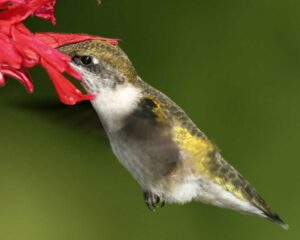By Bernheim

The Ruby-throated Hummingbird is eastern North America’s sole breeding hummingbird. The petite Ruby-throated Hummingbird has a slender bill that curves slightly downward and their wings are fairly short. Ruby-throated Hummingbirds have brilliant emerald or golden-green backs and crowns, with a gray-white underside. Males have a bright iridescent red throat. Female hummingbirds have a green back with a black mask with white behind the eyes with white underparts.
Ruby-throated Hummingbirds live in open woodlands, on the edges of forests, meadows, grasslands, and public green spaces as well as backyards. Their nests are the size of a large thimble. The birds build their nests directly on top of the branch rather than in a fork; the nests are usually constructed of thistle or dandelion down held together with strands of spider silk and sometimes pine resin. The nest building usually takes 6-10 days to complete and the finished nest measures about 2 inches across and 1 inch deep. Females build their nests on the slender, often descending branches, of deciduous trees such as oak, hornbeam, birch, poplar, or hackberry. Ruby-throated hummingbirds build their nests 10-40 feet above the ground and have been known to utilize loops of chain, discarded wire, and even hanging extension cords, in their nest building.
Ruby-throated Hummingbirds prefer to feed on red or orange flowers. Hummingbirds have stellar color vision and can see into the ultraviolet spectrum, an ability we as humans do not possess. Ruby-throated Hummingbirds are considered to be medium to long-distance migrants. The majority of Ruby-throated Hummingbirds fly across the Gulf of Mexico in order to overwinter in Central America, some birds stay in North America along the Gulf Coast, parts of the southern Atlantic coast, and at the tip of Florida. Like all hummingbirds, ruby-throats are precision flyers with the astounding ability to fly at full speed and then stop instantaneously as well as the ability to hover motionless midair. These amazing birds are truly a sight to behold, the awesome abilities of these birds should inspire us all to conserve and create habitat to sustain these beautiful birds. Invite them into your yard and you will be richly rewarded.

